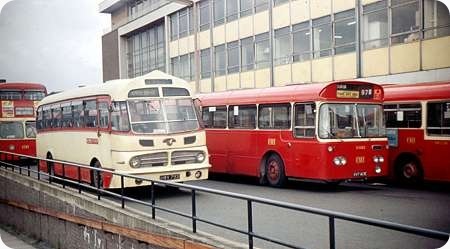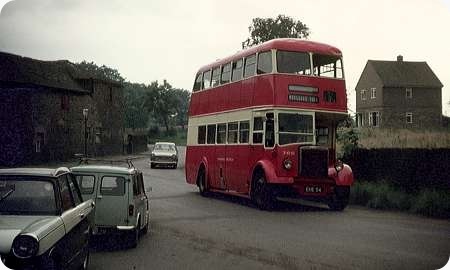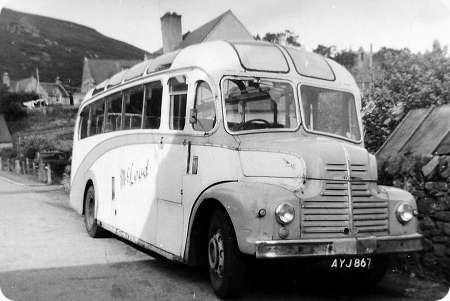Berresford Motors – Leyland Royal Tiger – HWV 793
Berresford Motors Ltd (Cheddleton)
1952
Leyland Royal Tiger PSU1/15
Harrington Contender C41C (1956)
Berresford’s ex Wilts and Dorset (originally Silver Star, Porton Down) Royal Tiger rounds the perimeter road of Longton Bus Station on 20th June 1971. This coach was new to Silver Star in July 1952 with a Leyland C41C body as built in large numbers for Ribble. It was fitted with the Harrington Contender Mk IV body in July 1956 after a serious accident earlier that year. It passed to Wilts and Dorset in June 1963 when that Company took over Silver Star’s operations. This information is taken from a series of articles on Silver Star in Buses Illustrated from February to April 1965.
Jim Berresford operated a mixed collection of second hand vehicles from his premises at Cheddleton. HWV is showing ‘Private’ on the blind but it could just as well have been operating on Berresford’s Longton – Leek service.
A collection of contemporary PMT buses are in the background. One of the final (1962) batch of Atlanteans of Stoke Depot on a Longton – Newcastle Estates working pursues HWV into the bus station whilst farebox fitted Roadliner 1063 of Longton Depot awaits its next trip to Blurton. Just in view is short Leopard 1124, another Longton allocated bus.
Photograph and Copy contributed by Ian Wild
10/11/13 – 08:02
If I remember rightly, Berresford’s was a bit of a rough and ready operation famous for it’s bus grave yard – old buses were simply dumped, withdrawn, in adjacent fields. They were big Leyland fans and had a number of ex Stockport all Leyland PD2s.
David Oldfield
10/11/13 – 17:33
This Harrington body was a variant of the type seen here on this site:
Maidstone & District – AEC Reliance – TKM 329 – C329 .
The Silver Star version seen above is rendered even uglier than the M&D style, in my opinion, by the grotesque front grilles that seemed to anticipate some of the later aberrations from the Duple stable. Thankfully, Harrington went on to redeem itself with the stylish Cavalier.
Roger Cox
11/11/13 – 08:31
The whole frontal appearance makes the body a potential Ugly Bus Page contender.
Phil Blinkhorn
11/11/13 – 15:32
I’ve seen this vehicle described as a Contender before, but surely it is a Wayfarer III? As far as I know the Contender model was for semi-chassisless vehicles such as the Commer-Harrington TS3s. However, for many years the LDB registered Harrington coaches delivered to North Western in 1958 were described in enthusiast publications as "Contenders" rather than Wayfarer IVs which is what they actually were! In that case the error went unchallenged until the vehicles had already been sold by NWRCC. Do we have any Harrington experts on board who can clarify this?
Neville Mercer
11/11/13 – 15:32
And the coach wears a sad face to express its own thoughts on its appearance, Phil.
Chris Hebbron
11/11/13 – 15:33
The body is a Harrington Wayfarer Mk 3, rather than a Contender, which was Harrington’s integral model fitted normally with a Rootes TS3 two stroke engine, apart from some for BOAC which had Rolls Royce petrol engines. The Wayfarer Mk 3 is described here:- www.thcoachwork.co.uk/way3.htm .
David Williamson
12/11/13 – 16:33
Maidstone & District had a large fleet of centre entrance Wayfarer/Reliances but also 3 similar looking but front entranced Commers, all of which were "TKM" registered.
Malcolm Boyland
13/11/13 – 12:54
You could say that Berresfords was a rough and ready operation but what a fascinating one! I always loved a trip from Leek to Hanley on the 16, or to Longton on the 106 because you really didn’t know what delight from the fleet would turn up next. I remember an ex-St Helens AEC Swift being on the stand in Longton bus station once and the driver couldn’t get reverse gear, all the passengers, some of whom were quite old, dutifully got off and helped to push the bus off the stand! It must be said though that everything Berresfords operated was smartly painted in fleet livery of red and ivory with the fleetname quite professionally applied. They were nearly always fitted with a destination blind of some sort. Such a shame that Jim Berresford’s untimely death brought it all to an end, it was one of those truly characterful operators which are sadly missed.
Chris Barker
10/12/13 – 06:38
Recent contributors may be interested to know that my book, Berresfords Motors of Cheddleton, is due to be published this week by MDS Books/Venture Publishing.
Eric Wain
11/12/13 – 06:30
Yes indeed Eric, I enquired about it at last Saturday’s Transport fair at the Manchester Museum. This is one volume I’m really looking forward to!
Chris Barker
23/12/13 – 08:34
I’ve just finished reading Eric’s book and can heartily recommend it. A decent history of Berresfords has been needed for donkey’s years and Eric has finally come up with the goods – and I would still be saying that even if we didn’t share a publisher!
Neville Mercer
03/03/14 – 07:26
Eric, I have just purchased and read your superb book on Berresfords, an operator that has long fascinated me (and no doubt many other enthusiasts) even though I only visited the depot a couple of times. A couple of points – you don’t mention in the book the large number of vehicles which must have been purchased for spares only, on both my visits a lot of the derelict buses seemed to fall into that category but I doubt there is any record. Amongst others the "West’s" RTL, and on my second visit a Western SMT Fleetline, GMT ex North Western RE and several ex NBC single deckers. My second query is how did Jim decide on withdrawal whether to keep a vehicle round the back for spares, or sell it on either for service or scrap. And whilst many obviously stayed in the yard for years, other derelicts must have been disposed of long before the PMT takeover.
Michael Keeley
20/05/14 – 08:30
Thank you, gentlemen, for your kind comments regarding my book. With regard to the withdrawn vehicles and those purchased for spares, there were two reasons why this aspect could not be covered. Given the large number of vehicles which fell into these categories over the years, it became obvious that other text or photos within the book would have to be forfeited in view of space limitations. Secondly, although there was much information available about many vehicles acquired for spares etc., it was known that the list would certainly be far from complete and it was decided not to produce an incomplete list.
From the early 1950s some vehicles withdrawn from the fleet were cannibalised and the bodies cut up rather than sold on. Some vehicles acquired for spares were treated similarly, whereas others donated useful major units and other parts and then were used for parts storage. One double-decker bought in 1949 actually donated its staircase which was incorporated into the rear of the extension of the office and workshop block! Unfortunately, I did not become aware of this until the book had been published.
Eric Wain
Quick links to the - Comments Page - Contact Page - Home Page



